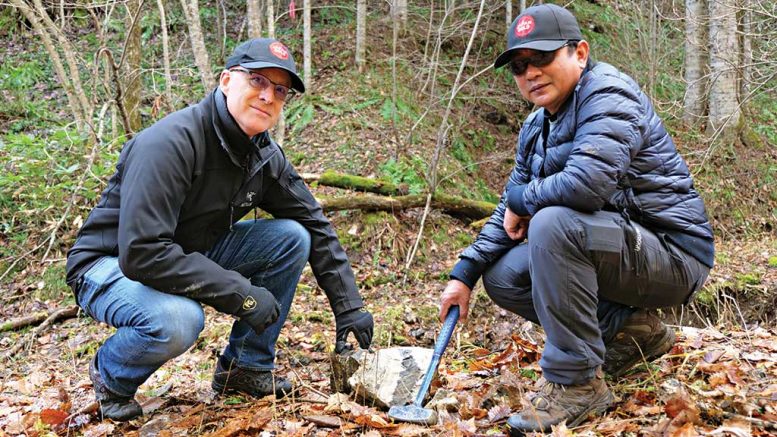Japan Gold (TSXV: JG; US-OTC: JGLDF) has become the first foreign company to be granted prospecting rights and a drilling permit by Japan’s Ministry of Economy, Trade and Industry for the Akebono prospect at its 100% owned Ikutahara gold project in Hokkaido in northern Japan.
Ikutahara covers 191 sq. km and 17 historic mines. Japan Gold has started drilling six holes totaling 1,000 metres to confirm and extend historic, high-grade underground sampling in the Akebono vein system. Sumiko Resources Exploration & Development, a wholly owned subsidiary of Sumitomo Metal Mining (TYO: 5713), will operate two of the drill rigs. The program will continue into late December, with results expected by February 2018.
“Sumiko had been very proactive and so had organized all the drill pads and equipment and had mobilized it all to site,” Japan Gold CEO John Proust says in an interview with The Northern Miner. “So literally the drill program commenced the day after we announced approval.”

Crew members setting up one of Japan Gold’s three diamond drill rigs in Japan. Credit: Japan Gold.
Akebono was discovered in 1931 and explored underground between 1938 and 1940. Exploration was then abandoned and didn’t resume until the 1960s. The Metal Mining Agency of Japan then published historical assay results in 1990, including a 1.2 metre wide sample grading 446 grams gold per tonne and 376 grams silver per tonne and a 0.65 metre wide sample grading 91.5 grams gold and 4,891 grams silver.
Proust says there was a flurry of gold mining activity leading up and during the Second World War, but the national government imposed a moratorium on gold mining in 1943.
After the war, some mines reopened and gold mining continued until the 1970s. There was little exploration until 2012, when Japan amended its Mining Act for the first time since 1950.
Previously, the Japanese government granted mining rights on a first come, first served basis. It did not ensure that rights holders had adequate financial and technical capabilities to actually undertake exploration or development.
As a result, many applications were filed to block other applicants from getting mining rights, leaving land unexplored and undeveloped.
These changes in 2012 also affected on foreign companies’ prospects in the country.
“Before the change in the act, foreign companies were not allowed to hold mineral exploration permits or mining permits in Japan — full stop,” Proust says. “Now we can go with modern technology and modern exploration methods into virgin territory — or at least, territory that had been in a time capsule for 40 years.”
Due to the lack of commercial mineral exploration, most university geology departments have closed down in Japan, Proust says.
The company therefore collaborated with the three main universities that still have geology departments: Hokkaido University, Kyushu University and Akita University.
With help from their data, Japan Gold acquired 210 prospecting licenses covering 695 sq. km and 17 separate projects — or 2% of the country’s land mass. Nearly all the properties are on Hokkaido island, with three on the southernmost Kyushu island and one at the north tip of the central Honshu island.
Thirteen properties lie on low-sulphidation epithermal areas, but four are on gold-bearing lithocaps. Japan Gold believes this could indicate porphyry mineralization.
The company is hoping to find something like the Hishikari gold mine, located in Kyushu. It was discovered in 1981 and has been operational since 1985. Owned by Sumitomo, it’s produced 7.4 million oz. gold at 40 grams gold per tonne. It continues to produce 200,000 oz. gold a year
“Our original excitement about Japan was really based on knowledge of the Hishikari mine,” Japan Gold president and COO Michael Andrews says.

Michael Andrews, Japan Gold’s president and COO.
When Japan Gold started looking into the geology of Japan in detail it noticed similarities in its volcanic and intrusive activities compared with the Philippines, Indonesia and Papua New Guinea. Andrews says these areas are associated with high-grade epithermal gold deposits, but also have large, lower grade copper-gold deposits.
“When you look around the Pacific Rim,” Andrews continues, “there’s a big gap between the Philippines and up to Alaska, called Japan. We felt that the cause of this gap is really a lack of exploration rather than a lack of geology.”
Japan Gold intends to keep the Ikutahara property and the three Kyushi properties for itself, but wants to form joint ventures for the others.
“We think the best way to advance a huge portfolio like this is in partnerships,” Proust says.
Japan Gold completed a $5 million private placement with Southern Arc Minerals (TSXV: SA) in August 2017, and has $3.6 million of working capital.
Shares of Japan Gold are currently priced at 35¢, with a 52-week trading range of 24¢ and 40¢. The company has a market cap of $24 million.


Be the first to comment on "Japan Gold drills Ikutahara in Hokkaido"